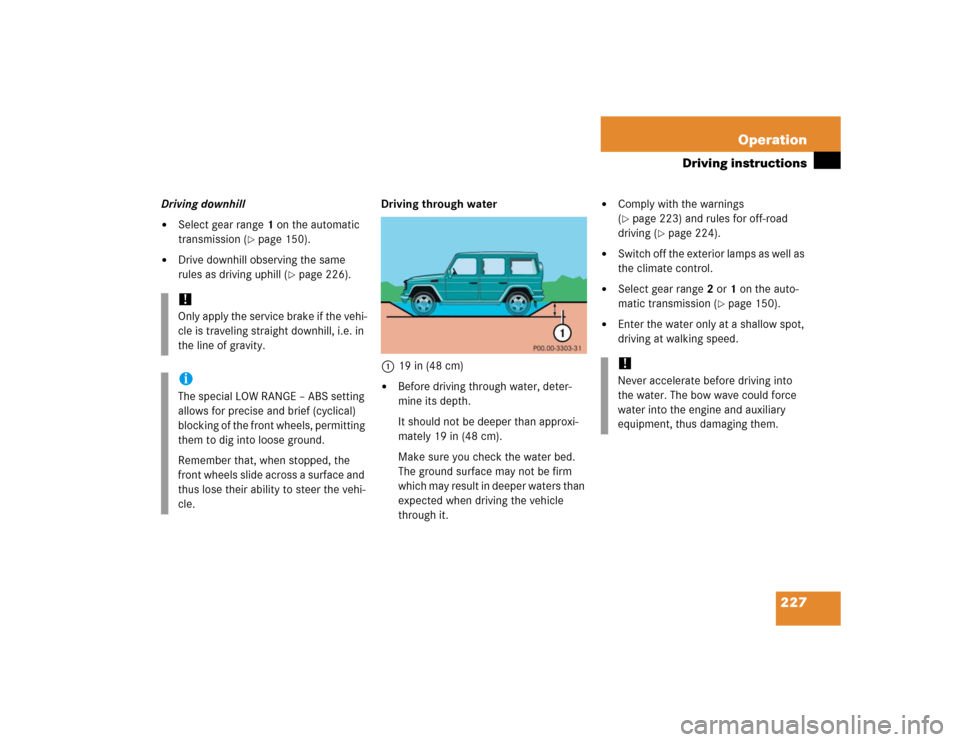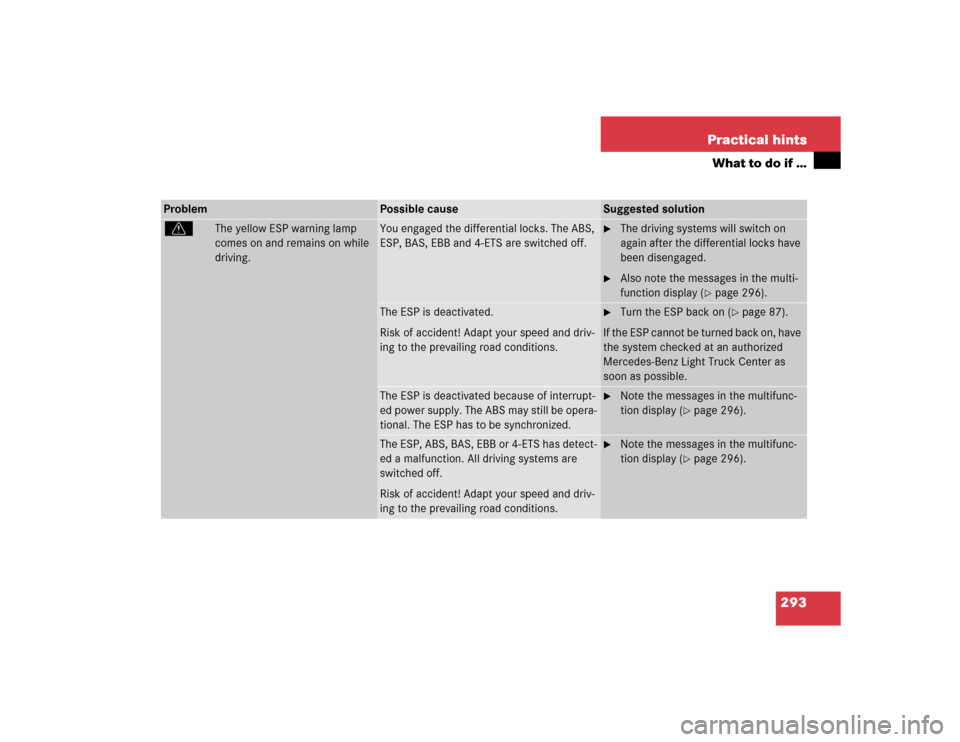Page 224 of 416

224 OperationDriving instructionsRead this chapter carefully before you be-
gin off-road travel.
Familiarize yourself with the vehicle char-
acteristics and gear changing before you
attempt any difficult terrain off-road driv-
ing. We recommend that you start out with
easy off-road travel.Special driving features for off-road
driving
The following driving features are available
for specific kind of operation:
�
ABS (
�page 80)
�
ESP (
�page 84)
�
4-ETS (
�page 83)
�
Differential lock (
�page 156)
�
Transfer case (
�page 154)
Off-road driving rules
�
Engage the transfer case in position
LOW before driving under off-road con-
ditions (
�page 154).
�
If necessary activate differential locks
(�page 158).
The ABS, BAS and ESP are switched off
automatically when the differential
locks are activated.
�
Fasten items being carried as securely
as possible (
�page 187).
Never let the vehicle roll backwards in idle.
You may lose control of the vehicle if you
use only the brake.
Sand, dirt, mud and other material having
friction property can cause exceptional wear
and tear as well as brake failure.
Have the brakes checked for dirt build-up
and cleaned. There is otherwise a risk that
full braking power may not be available in an
emergency.
iWhenever driving in off-road mode, we
recommend:�
Keeping doors, tailgate, windows
and tilt/sliding sunroof closed.
�
Switching cruise control off.
!Observe the following during off-road
driving:�
Adjust vehicle speed to condition of
terrain. The more uneven, rutty and
steeper the terrain, the lower the
speed should be. Drive through wa-
ter slowly at an even speed, avoid-
ing a bow wave.
�
Be especially careful when driving
in unknown territory. It may be nec-
essary to get out of the vehicle and
scout the path you intend to take.
�
Watch out for obstacles, such as
rocks, holes, tree stumps and ruts.
��
Page 227 of 416

227 Operation
Driving instructions
Driving downhill�
Select gear range1 on the automatic
transmission (
�page 150).
�
Drive downhill observing the same
rules as driving uphill (
�page 226).Driving through water
119 in (48 cm)
�
Before driving through water, deter-
mine its depth.
It should not be deeper than approxi-
mately 19 in (48 cm).
Make sure you check the water bed.
The ground surface may not be firm
which may result in deeper waters than
expected when driving the vehicle
through it.
�
Comply with the warnings
(�page 223) and rules for off-road
driving (
�page 224).
�
Switch off the exterior lamps as well as
the climate control.
�
Select gear range2 or1 on the auto-
matic transmission (
�page 150).
�
Enter the water only at a shallow spot,
driving at walking speed.
!Only apply the service brake if the vehi-
cle is traveling straight downhill, i.e. in
the line of gravity.iThe special LOW RANGE – ABS setting
allows for precise and brief (cyclical)
blocking of the front wheels, permitting
them to dig into loose ground.
Remember that, when stopped, the
front wheels slide across a surface and
thus lose their ability to steer the vehi-
cle.
!Never accelerate before driving into
the water. The bow wave could force
water into the engine and auxiliary
equipment, thus damaging them.
Page 265 of 416
265 Operation
Tires and wheels
All-season and winter tires
Load identification
1Load identificationIn addition to tire load rating, special load
information may be molded into the tire
sidewall following the letter designating
the tire speed rating1 (
�page 265).
No specification given: absence of any text
(like in above example) indicates a
standard load (SL) tire.
XL (Extra Load): designates an extra load
(or reinforced) tire.
Light Load: designates a light load tire.
C, D, E: designates load range associated
with the maximum load a tire can carry at
a specified pressure.
Index
Speed rating
QM+S
up to 100 mph (160 km/h)
TM+S
up to 118 mph (190 km/h)
HM+S
up to 130 mph (210 km/h)
VM+S
up to 149 mph (240 km/h)
iThe marking “M+S” next to the service
description designates tires with mud
and snow capabilities.
iFor illustration purposes only. Actual
data on tires are specific to each vehi-
cle and may vary from data shown in
above illustration.
Page 275 of 416

275 Operation
Winter driving
�Winter driving
Before the onset of winter, have your
vehicle winterized at an authorized
Mercedes-Benz Light Truck Center. This
service includes:�
Check of anticorrosion and antifreeze
concentration.
�
Addition of cleaning concentrate to the
water of the windshield and headlamp
cleaning system. Add MB Concentrate
“S” to a premixed windshield washer
solvent/antifreeze which is formulated
for below freezing temperatures
(�page 380).
�
Battery test. Battery capacity drops
with decreasing ambient temperature.
A well charged battery helps to make
sure that the engine can be started,
even at low ambient temperatures.
�
Tire change. Mercedes-Benz recom-
mends M+S rated radial-ply tires with a
minimum tread depth of approximately 1/6in (4 mm) on all four wheels for the
winter season.
Winter tires
Always use winter tires at temperatures
below 45°F (7°C) and whenever wintry
road conditions prevail. Use of winter tires
is the only way to achieve the maximum ef-
fectiveness of the ABS, ESP, 4-ETS, and
EBP in winter operation.
For safe handling, make sure that all
mounted winter tires are of the same make
and have the same tread design.Always observe the speed rating of the
winter tires installed on your vehicle. If the
maximum speed for which your tires are
rated is below the speed rating of your
vehicle, you must place a notice to this
effect where it will be seen by the driver.
Such notices are available from your tire
dealer or from any authorized
Mercedes-Benz Light Truck Center.Warning!
G
Winter tires with a tread depth under
1/6in
(4 mm) must be replaced. They are no
longer suitable for winter operation.
Warning!
G
If you use your spare tire when winter tires
are fitted on the other wheels, be aware that
the difference in tire characteristics may
very well impair turning stability and that
overall driving stability may be reduced.
Adapt your driving style accordingly.
Have the spare tire replaced with a winter
tire at the nearest authorized
Mercedes-Benz Light Truck Center.
Page 288 of 416

288 Practical hintsWhat to do if …Lamps in instrument clusterGeneral information:
If any of the following lamps in the instru-
ment cluster fails to come on during thebulb self-check when switching on ignition,
have the respective bulb checked and re-
placed if necessary.Problem
Possible cause
Suggested solution
-
The yellow ABS indicator lamp
comes on while driving.
You engaged the differential locks. The ABS,
ESP, BAS, EBB and 4-ETS are switched off.
�
The driving systems will switch on
again after the differential locks have
been disengaged.
The ABS has detected a malfunction and has
switched off. The ESP, BAS, EBB and 4-ETS
are also switched off (see messages in dis-
play).
If the ABS control unit is malfunctioning, oth-
er systems such as the navigation system or
Rear Parking Assist* may also malfunction.
The brake system is still functioning normally
but without the ABS available.
�
Continue driving with added caution.
Wheels will lock during hard braking
reducing steering capability.
�
Have the system checked at an autho-
rized Mercedes-Benz Light Truck
Center as soon as possible.
Failure to follow these instructions in-
creases the risk of an accident.
Page 289 of 416
289 Practical hints
What to do if …
Problem
Possible cause
Suggested solution
-
The yellow ABS indicator lamp
comes on while driving.
The ABS has switched off because charging
voltage has fallen below 10 volts. The battery
may not be charged.
�
Turn off unnecessary electric con-
sumers.
When the battery voltage is above this
value again, the ABS is operational
again.
�
Note the messages in the multifunc-
tion display (
�page 296).
Page 291 of 416
291 Practical hints
What to do if …
Problem
Possible cause
Suggested solution
;
(USA only)
3
(Canada only)
-
The red brake warning lamp and
the yellow ABS indicator lamp
come on when the engine is run-
ning and you hear a warning
sound for approximately five sec-
onds.
The EBB has detected a malfunction and has
switched off. You should be prepared for your
vehicle to perform differently than normal
when braking.
�
Continue driving with added caution.
�
Have the system checked at an autho-
rized Mercedes-Benz Light Truck
Center as soon as possible.
�
Also note the messages in the multi-
function display (
�page 296).
Failure to follow these instructions in-
creases the risk of accidents.
Page 293 of 416

293 Practical hints
What to do if …
Problem
Possible cause
Suggested solution
v
The yellow ESP warning lamp
comes on and remains on while
driving.
You engaged the differential locks. The ABS,
ESP, BAS, EBB and 4-ETS are switched off.
�
The driving systems will switch on
again after the differential locks have
been disengaged.
�
Also note the messages in the multi-
function display (
�page 296).
The ESP is deactivated.
Risk of accident! Adapt your speed and driv-
ing to the prevailing road conditions.
�
Turn the ESP back on (
�page 87).
If the ESP cannot be turned back on, have
the system checked at an authorized
Mercedes-Benz Light Truck Center as
soon as possible.
The ESP is deactivated because of interrupt-
ed power supply. The ABS may still be opera-
tional. The ESP has to be synchronized.
�
Note the messages in the multifunc-
tion display (
�page 296).
The ESP, ABS, BAS, EBB or 4-ETS has detect-
ed a malfunction. All driving systems are
switched off.
Risk of accident! Adapt your speed and driv-
ing to the prevailing road conditions.
�
Note the messages in the multifunc-
tion display (
�page 296).